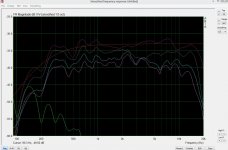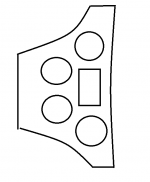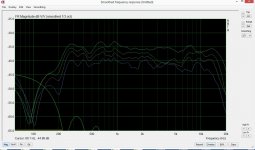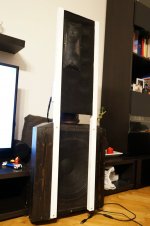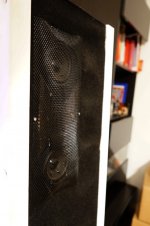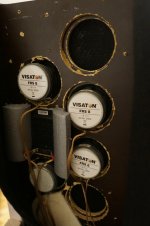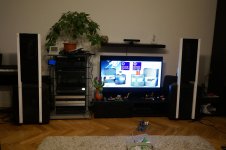Following the discussion in this thread, here's a preliminary results of a 4-driver two-dimensional array + planar waveguided tweeter in a dipole configuration (the four 3" wideband units, Visaton FRS8 are placed in a semi-circle around the Neo 8 PDR tweeter on a customized baffle shape. The "outer" two of them are rolled off earlier such that they only contribute in the lower frequency range)
Measurements show 0-30-45-60 degree horizontal response at 1.5 meters with a ~10ms gate in a room (which is rather large, but still will show some reflections). A smaller gate yields smoother response, but starts to miss the dipole effect.
Some remarks:
1. Design goal is constant directivity over a broad range (ideally 300Hz - 4kHz) with no crossover in this area. Currently this works well up to ~2kHz, where it shortly blooms and then directivity goes back again, although not so smoothly controlled as in the dipole area. Crossover is 2nd order LR at~3.5kHz, which does not quite meet the goal, but worked best so far. I intend to try out a 1st order at ~4kHz, something both the wideband drivers and the tweeter(probably with closed back) can handle, but not sure about the off-axis response. Need to try.
2. The blooming at 2kHz look like the dipole peak of the two units inline with the tweeter, which "see" a narrower baffle (further separate measurements of midrange / tweeter are needed and planned) . I see two ways of further improve it which I will try:
- further pushing up the dipole peak. This might be hard or impossible due to the physical baffle constraints.
- use driver directivity, i.e., have the "outer" 2 units roll off upper in frequency such that the dipole peak does not occur at all (by increasing the apparent source size). This was actually my initial idea of using both dipole and driver directivity
3. The waveguide on the tweeter could do a better job
4. During the work on this, I have become a bit skeptical about the real need to improve directivity further. The system already sounds very good. Of course we all want "by the book" directivity, but, as often pointed out, there is a diminishing return somewhere. I'm not saying I'm there, just that we need to keep it in mind.
Measurements show 0-30-45-60 degree horizontal response at 1.5 meters with a ~10ms gate in a room (which is rather large, but still will show some reflections). A smaller gate yields smoother response, but starts to miss the dipole effect.
Some remarks:
1. Design goal is constant directivity over a broad range (ideally 300Hz - 4kHz) with no crossover in this area. Currently this works well up to ~2kHz, where it shortly blooms and then directivity goes back again, although not so smoothly controlled as in the dipole area. Crossover is 2nd order LR at~3.5kHz, which does not quite meet the goal, but worked best so far. I intend to try out a 1st order at ~4kHz, something both the wideband drivers and the tweeter(probably with closed back) can handle, but not sure about the off-axis response. Need to try.
2. The blooming at 2kHz look like the dipole peak of the two units inline with the tweeter, which "see" a narrower baffle (further separate measurements of midrange / tweeter are needed and planned) . I see two ways of further improve it which I will try:
- further pushing up the dipole peak. This might be hard or impossible due to the physical baffle constraints.
- use driver directivity, i.e., have the "outer" 2 units roll off upper in frequency such that the dipole peak does not occur at all (by increasing the apparent source size). This was actually my initial idea of using both dipole and driver directivity
3. The waveguide on the tweeter could do a better job
4. During the work on this, I have become a bit skeptical about the real need to improve directivity further. The system already sounds very good. Of course we all want "by the book" directivity, but, as often pointed out, there is a diminishing return somewhere. I'm not saying I'm there, just that we need to keep it in mind.
Attachments
I was just about to patent it, but since you asked..
It looks like a bull head lying on one sideThe idea is that the drivers inline with the tweeter should "see" a narrower baffle.
Wouldn't a symmetrical array be better?
You'll get a symmetrical polar response.
Sorry, my bad: I meant Neo 3, not 8, which not exactl a tweeter. The wavegude is a very (probably too) shallow vertical one made out of two halved pipes.
I was thinking that's probably what you meant. Cool project nonetheless.
Wouldn't a symmetrical array be better?
You'll get a symmetrical polar response.
In principle, symmetrical would better and one could do a full circle around the tweeter. At this point, however, I am not convinced that the added complexity is worth it. The experiment needs to be carried on a bit further.
BTW, I've found a very interesting paper on circular arrays, although in a different context (small mobile devices). I can't fully follow the math (it's been a while), but the plots are easier to understand. They basically derive an analytical solution how to drive a set of concentric ring radiators (or arrays) in magnitude and phase such that to emulate an oscillating sphere.
http://mellowacoustics.com/articles/Dipole_speaker_with_balanced_directivity.pdf
I have been using a 2D dipole array without CD for about 6 months. I have documented it on Part Express Tech Talk (Discus-an-open-baffle-shaded-spherical-segment-FAST-array). Spaciousness is really good. It has about the best "phantom center" image of anything I have heard. When you close your eyes, you cannot pinpoint the source, yet the imaging is both precise and has depth. I don't want to hijack the thread, just let you know about possibilities.
Marc

Marc
Msibilia interesting idea ! How about the off-axis response, did you take any measurements on that ?
I tweaked the crossover a bit on mine today. It's now quasi 1st order@4kHz. Directivity improved significantly, I would say, but there is still room for improvement.
I tweaked the crossover a bit on mine today. It's now quasi 1st order@4kHz. Directivity improved significantly, I would say, but there is still room for improvement.
Attachments
Because they are multiple sources, I need to make measurements at listening distance or greater to let the wavefronts merge. Also, being open baffle, they interact strongly with the front wall (behind the speakers) and my room isn't large enough to get good measurements indoors. I haven't taken them outdoors yet to measure because right now they hang from hooks on my basement ceiling and I haven't gotten around to making stands. They have a wide enough 'beam' to cover three seats on the sofa at 8 feet clearly, but definitely begin to roll off at about 30 degrees off axis. I need to get some off axis measurements.
Marc
Marc
It would be interesting to see off-axis measurements even in the room with say 5ms gate. This would give useful information above a few hundred Hz.
I am currently thinking a lot around the multiple driver approach. My current thoughts:
- a large number of drivers is problematic. In the past, I have tried a line array dipole with 10 drivers. In spite of promising measurements, it NEVER sounded good. Always lacked this and that.
- a 2d array always sounded better and can be an excellent tool to control directivity. But it can get complex: ideally, one would need a multi-channel DSP to control drivers more or less individually.
If you look at the paper I quoted above, you see that both magnitude and phase (delay) are specifically controlled for each concentric circle of drivers to yield the desired response (in this case, the dipole pattern of an oscillating sphere). One can imagine also other directivity patterns, possible narrower: the math for that won't be trivial and implementation only doable with DSP
Currently, I am running a 4-driver array + tweeter and that works really well, yielding a good polar from 300Hz up to 20kHz (with the exception of a faster directivity transition around 3-4 kHz, but still ending up smooth). It sounds very good with great imaging and spaciousness. I think it works well because it is simple enough to control in analogue domain. If I had to go for a large 2D array I'd go the DSP way and do some math as per paper.
I am currently thinking a lot around the multiple driver approach. My current thoughts:
- a large number of drivers is problematic. In the past, I have tried a line array dipole with 10 drivers. In spite of promising measurements, it NEVER sounded good. Always lacked this and that.
- a 2d array always sounded better and can be an excellent tool to control directivity. But it can get complex: ideally, one would need a multi-channel DSP to control drivers more or less individually.
If you look at the paper I quoted above, you see that both magnitude and phase (delay) are specifically controlled for each concentric circle of drivers to yield the desired response (in this case, the dipole pattern of an oscillating sphere). One can imagine also other directivity patterns, possible narrower: the math for that won't be trivial and implementation only doable with DSP
Currently, I am running a 4-driver array + tweeter and that works really well, yielding a good polar from 300Hz up to 20kHz (with the exception of a faster directivity transition around 3-4 kHz, but still ending up smooth). It sounds very good with great imaging and spaciousness. I think it works well because it is simple enough to control in analogue domain. If I had to go for a large 2D array I'd go the DSP way and do some math as per paper.
From my side, short version: no.
I am happily listening to the version I've presented above. The sound is excellent, as is the imaging with rolled-off back radiation (see this thread for more details on why I think this is necessary: http://www.diyaudio.com/forums/multi-way/268634-r16-constant-directivity-dipoles-4.html#post4230981)
Thus, other than theoretical perfection, I have little motivation to improve the polar response even further - it's not from perfect, but my gut feeling is that further improvements will not be audible. I might be wrong, of course.
There ARE, however, some things I'd like to try:
1. a symmetrical 2D array (for symmetrical polar response). This might require a different kind of power tapering and level matching or a more sensitive tweeter.
2. a dipole Synergy-like horn (or actually waveguide). That would mean: baffle no longer flat, but the shape of a relatively shallow waveguide, mounting the full ranges from the back of the baffle through ports a la Synergy and having the tweeter in the middle of the waveguide.
Potential advantages: closer spacing of the sources (apparent acoustic centers - the input ports - can be close to the tweeter) and better HF radiation control (due to the larger waveguide).
Potential disadvantages: poorer response at the back. Need to try.
I'll put some pictures of the speaker soon.
I am happily listening to the version I've presented above. The sound is excellent, as is the imaging with rolled-off back radiation (see this thread for more details on why I think this is necessary: http://www.diyaudio.com/forums/multi-way/268634-r16-constant-directivity-dipoles-4.html#post4230981)
Thus, other than theoretical perfection, I have little motivation to improve the polar response even further - it's not from perfect, but my gut feeling is that further improvements will not be audible. I might be wrong, of course.
There ARE, however, some things I'd like to try:
1. a symmetrical 2D array (for symmetrical polar response). This might require a different kind of power tapering and level matching or a more sensitive tweeter.
2. a dipole Synergy-like horn (or actually waveguide). That would mean: baffle no longer flat, but the shape of a relatively shallow waveguide, mounting the full ranges from the back of the baffle through ports a la Synergy and having the tweeter in the middle of the waveguide.
Potential advantages: closer spacing of the sources (apparent acoustic centers - the input ports - can be close to the tweeter) and better HF radiation control (due to the larger waveguide).
Potential disadvantages: poorer response at the back. Need to try.
I'll put some pictures of the speaker soon.
Thanks for quick response 
yeeeiiiiii
............................
I'll put some pictures of the speaker soon.
yeeeiiiiii
Allright, here's how they look. The baffles are rectangular in shape, but there are holes in them (from previous configurations) that act as acoustic "short circuits". The bakc is covered with felt (not seen in the picture)
Attachments
- Status
- This old topic is closed. If you want to reopen this topic, contact a moderator using the "Report Post" button.
- Home
- Loudspeakers
- Multi-Way
- 2D dipole array with CD (follow up from the 1-4kHz thread)
